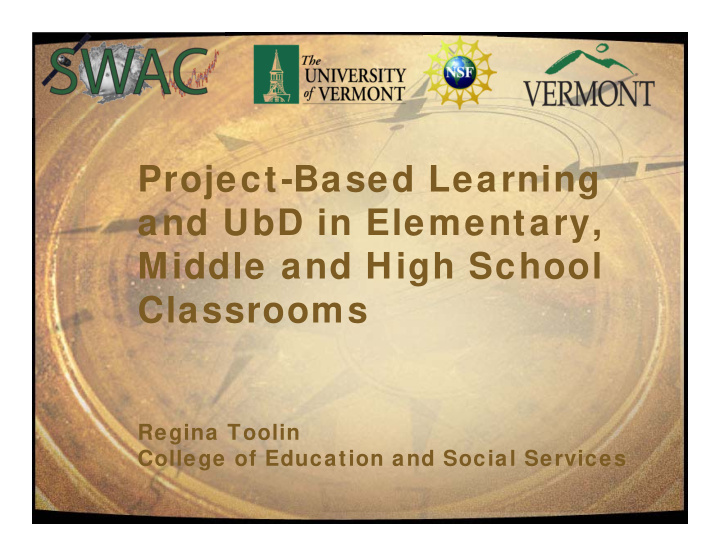



Project-Based Learning and UbD in Elementary, Middle and High School Classrooms Regina Toolin College of Education and Social Services
Sort & Mingle Warm-Up! Sort Do you prefer…??? – Hot, humid vs. cold, snowy days – Cloud watching vs. star gazing – Rain vs. snow – Cumulous vs. stratus clouds – NOAA.Gov or Weather.Com
Sorts and Mingle Warm-Up! Mingle • What is your favorite place on Earth? • What is your favorite season? • What is your favorite outdoor activity? • What is your favorite weather/climate topic to teach? • What is your least favorite weather/climate topic to teach?
The Magic Wand • What would you do if you just found a magic wand that allows you to change three things about the way that science is taught. • What would you change? • Why it is important to make these changes?
Session Objectives 1. What is Project-Based Learning (PBL)? – Principles – Traditional Classroom vs. PBL Classroom 2. What is Understanding by Design (UbD)? 3. How are PBL and UbD applied to SWAC?
What do you know …? • … about project-based learning? • … about understanding by design? • http://videos.hightechhigh.org/
What is Project-Based Learning? Project-based learning is • a teaching and learning approach that focuses on the big ideas of a discipline or disciplines, • involves students in problem-posing, problem solving and other meaningful tasks, • allows students to work autonomously to build their own learning over an extended period of time, • and culminates in realistic, student-generated products.
Project-based learning… • Deeply involves students in interdisciplinary experiences rooted to subject matter • Focuses on students discovering questions and answers • Encourages students to be independent learners with group support • Allows students to create unique student products that support their understanding
Principles of PBL • Learner-centered • Authentic content and purpose • Challenging projects • Product, presentation, performance or exhibition • Collaborative and cooperative learning • Incremental and continual improvement • Teacher facilitated • Explicit educational goals • Integrates technology
How does PBL influence teachers and teaching? • Teachers are generally enthusiastic, motivated, and successful in their quest to implement project-based learning in their science classrooms (Rosenfield and Ben-Hur, 2001). • Collaborative PBI curriculum development resulted in positive change in teachers ’ understanding and practice of science and science teaching (Blumfield, 1994). • School culture and mission and teacher prior knowledge and experience of PBI played a significant role in teachers successfully implementing PBI in secondary science classrooms (Toolin, 2004). • PBI presents challenges to teachers in course and assessment design or the revision of existing ones (D ’ Amico, 1999).
How does PBL influence student learning and motivation? • PBL maximizes the use of technological tools for analyzing, presenting, and communicating results (Grant, 2002; Morrison & Lowther, 2005). • Student motivation and learning science significantly increased in PBL classrooms (Marx, 1994; Stratford & Finkel, 1996). Underrepresented HS students ’ interest in science and science • teaching increased as a result of engaging in a PBL summer program (Toolin, 2003). • Student collaboration and the use of technology increased as teachers enacted several aspects of project-based science in their teaching practice (Marx, 1994). • Student motivation and commitment to learning heightened while developing ocean software projects. (Yarnell)
Differences in Traditional and PBL Instruction* Feature Traditional PBL Curriculum Textbook driven Problem-solving Sequence Fixed units Interdisciplinary Assessment Test and compare Criteria based Technology Peripheral Central, integral Classroom Working alone Works in groups Student role Receiver Discoverer Goals Mastery of facts Understanding and application Source: Buck Institute for Education http://www.bie.org/pbl/pbloverview/instruction.php
Curriculum Planning & Backw ard Design http://www.youtube.com/watch?v=6Cagh0H7PPA&feature=related 1. Identify Desired Results 2. Determine Acceptable Evidence 3. Plan Learning Experiences ( Adapted from Wiggins and McTighe, 2003)
Begin w ith the End in Mind! • What will your students know and be able to do as a result of this unit project? • How will they interact and relate to each other and to adults? • How will they think? How will they think about their own learning? Most Importantly…… • How will students apply AND transfer their knowledge in the real world? • How will the real world influence your student and your curriculum?
What ’ s the Big Idea? • What are the enduring understandings or big ideas that students will know and be able to do by the end of the unit project? • Examine national, state, district standards & Principles of Learning (see nylearns.org, eservices.nysed.gov/vls) • Review curriculum expectations and other resources • Establish curricular priorities
Create it! PBL Planning: • The Vision Stage – Determining the Big Idea • Inquiry Stage – What is the desired result and how will students know when they have reached it? • Build Stage – Planning the Learning Experiences • Reflection Stage – Reflecting on how to improve the project
Model it! • Project Planner • Example from past participant – Sharron M. Prairie • If time allows, more from Wiggins… • http://www.youtube.com/watch?v=WsD gfC3SjhM&feature=related
Wrap it up! • PBL Possibilities are endless • Motivation and excitement for learning will increase • Connected and collaborative learning will occur • Students retain learning beyond testing • Transfer of learning is the ultimate goal.
A Tour of the SWAC Website • uvm.edu/~swac
References http://www.ci.maryville.tn.us/schools/bennett%20PBL%20wTech.ppt#256,1,Project- Based Learning Buck Institute for Education http://www.bie.org/pbl/pbloverview/instruction.php http://www7.nationalacademies.org/bose/Standards_Framework_Public_Draft_Cover_Letter.html http://videos.hightechhigh.org/ http://www.terc.edu/ourwork/g_38_3_sci.html http://imet.csus.edu/imet2/stanfillj/workshops/pbl/description.htm#Project Examples
Recommend
More recommend